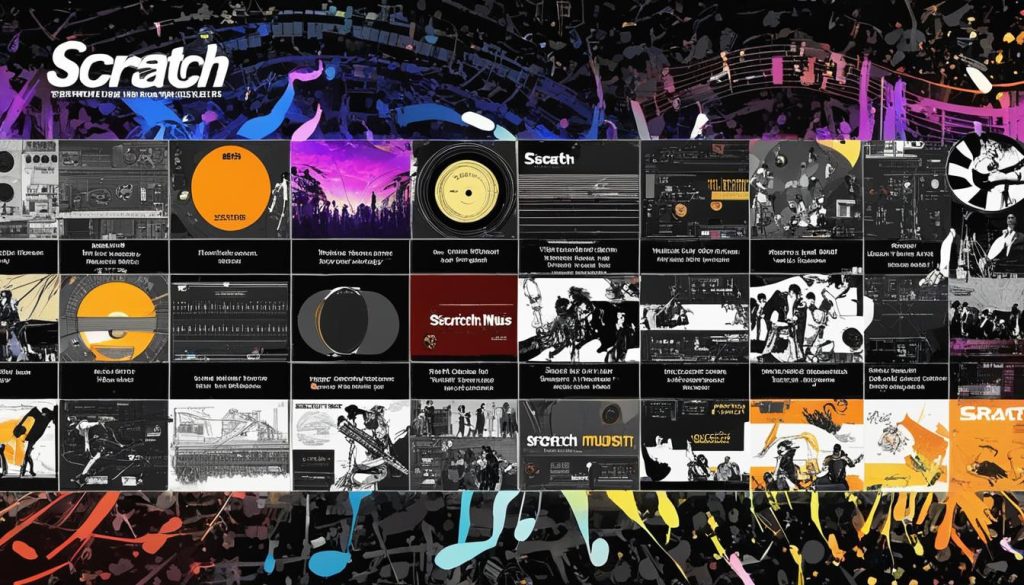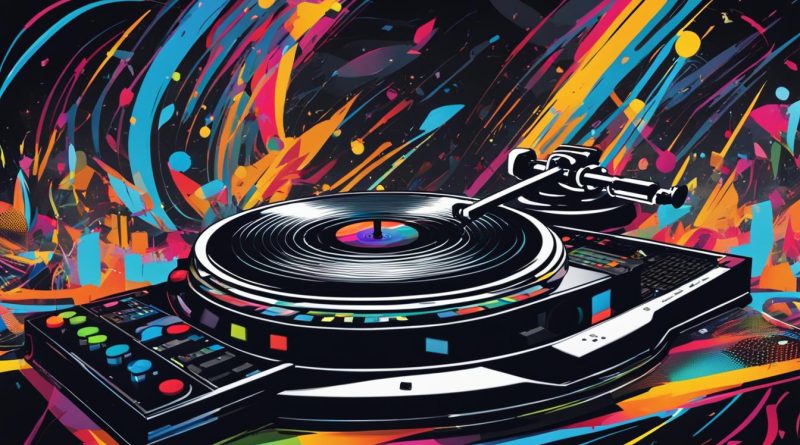Exploring Scratch Music: Creation & Education
Scratch music is a genre of music that merges creativity, sound, and innovation. It is a unique form of music that allows artists to create compositions using scratching techniques on turntables and other audio equipment. The genre is significant in the music industry and has gained widespread adoption in recent years, especially in music education programs.
Scratch music is not just a genre of music but also a creative process that involves manipulating sound, incorporating various elements, and reimagining existing sounds to produce innovative content. It involves experimenting with different rhythms, layering sounds and textures, and using technology to create unique compositions.
In this article, we will delve into the origins and evolution of scratch music, its role in music creation and production, and how it is reshaping music education.
Key Takeaways
- Scratch music is a unique form of music that merges creativity, sound, and innovation.
- It involves manipulating sound, incorporating various elements, and reimagining existing sounds to produce innovative content.
- Scratch music has gained popularity in recent years, especially in music education programs.
- The genre has its roots in DJing and turntablism, and it has helped reshape the music industry.
- Incorporating scratch music into music education programs can help students develop musical skills, creativity, and innovation.
The Evolution of Scratch Music
Scratch music has its roots in DJing and turntablism, where DJs would use turntables to create new sounds by manipulating records. According to The Vinyl Ain’t Final: Hip Hop & The Globalization of Black Popular Culture, the history of scratch music can be traced back to the 1940s, when experimental musicians began manipulating vinyl records by hand to create new sounds and compositions.
In the early 1970s, Grandmaster Flash, a hip-hop pioneer, developed the concept of “cutting” and “scratching” records, where a DJ would manipulate a vinyl record manually while it was spinning on a turntable. This technique involved moving the vinyl back and forth and using the crossfader on the mixer to create a rhythmic sound. This technique quickly caught on and became a staple of the hip-hop genre.
“You take the hit record, and you take an instrumental side… you take the positive part of one record and the positive part of another record and you put them together… and you got something different from what both of them were.” – Grandmaster Flash
As turntablism continued to evolve, DJs began to incorporate more complex scratch techniques into their compositions, including the chirp, crab, and flare scratches. With the advent of digital technology, scratch music has continued to evolve, with DJs incorporating software and digital tools into their sets.

Today, scratch music has become an established genre in its own right, with its own musicians, competitions, and communities. It has also had a significant impact on the music landscape, influencing other genres like rock, pop, and electronic music.
The Impact of Scratch Music on Music Education
Scratch music has also had an impact on music education, with many institutions incorporating turntablism and DJing into their music programs. At the Berklee College of Music in Boston, students can take a course on turntablism and learn about the history of the technique, its musical applications, and its hands-on uses in music production.
Scratch music has opened up new possibilities for music education, allowing learners to explore different techniques and styles and experiment with new forms of music creation and sound manipulation.
Scratch Music in Composition and Production
In the world of music production, scratch music has become an essential component of the creative process. Its unique sound manipulation techniques have been adopted by many contemporary artists to produce innovative compositions that resonate with audiences around the world.
Scratching involves manipulating vinyl records on turntables using a variety of techniques to create unique sounds. DJs and producers use scratching to incorporate rhythmic loops, scratchy melodies, and other musical effects into their tracks, adding layers of texture and interest to their music.
The creative process involved in scratch music production requires a high level of skill and concentration. DJs must have a deep understanding of rhythm and timing and be able to execute precise movements to create the desired sounds. They must also have a keen ear for music and be able to layer different sounds to create a cohesive and interesting composition.

The sound manipulation involved in scratch music is what sets it apart from other genres of music production. DJs can manipulate sounds in real-time, allowing them to be creative and spontaneous with their music. They can create unexpected sounds, transitions, and effects that keep the audience engaged and connected with the music.
Overall, scratch music has had a significant impact on music production, offering new and exciting ways to create music. Its ability to merge technology and creativity has opened up endless possibilities for artists and producers, making it an essential tool for musicians in today’s music industry.
Conclusion
In conclusion, scratch music is an innovative genre that is reshaping the landscape of music creation and education. As discussed in the previous sections, scratch music merges creativity and sound to create unique compositions that are taking the music industry by storm.
With its roots in DJing and turntablism, scratch music has evolved into a genre of its own, with artists using scratching techniques to manipulate sounds, create new rhythms, and add layers of texture to their music.
Scratch music is not only a creative outlet for artists, but it also has the potential to reshape music education programs. By incorporating scratch music into their curriculums, educators can expose students to new and innovative ways of creating music while encouraging their creativity and imagination.
As scratch music continues to gain popularity, its impact on the future of music production cannot be underestimated. The genre has opened up new possibilities for artists to experiment with sound and push the boundaries of what is possible in music.
In conclusion, scratch music is an exciting and innovative genre that has the potential to reshape music education and the music industry itself. It is a unique form of creative expression that encourages creativity, experimentation, and innovation – all qualities that are essential for pushing the boundaries of music and exploring new avenues of expression.
Frequently Asked Questions
What is scratch music?
Scratch music is a genre that merges creativity and sound manipulation to create innovative compositions. It involves using turntables and DJ techniques to scratch and manipulate vinyl records, creating unique rhythms and textures in music.
What is the history of scratch music?
Scratch music has its roots in DJing and turntablism. It emerged in the 1970s as DJs began experimenting with manipulating vinyl records to create new sounds. Over time, scratch music evolved as a genre in its own right, with artists pushing the boundaries of what could be accomplished through scratching and sound manipulation.
How is scratch music used in composition and production?
Scratch music plays a significant role in composition and production. Artists use scratching techniques to manipulate sounds, create unique rhythms, and add layers of texture to their music. By incorporating scratch elements into their compositions, artists can bring a distinct and innovative sound to their work.
What is the creative process involved in scratch music production?
The creative process in scratch music production involves exploring different sound samples, experimenting with scratching techniques, and finding ways to incorporate scratch elements into the overall composition. Artists often rely on their creativity and experimentation to push the boundaries of what can be achieved through scratching and sound manipulation.
How is scratch music reshaping music education?
Scratch music is reshaping music education by introducing students to a new and innovative genre of music creation. By incorporating scratch techniques into music education programs, students can explore new avenues of creativity and gain a deeper understanding of the possibilities within music production.
What is the potential impact of scratch music on the future of music production?
Scratch music has the potential to inspire new approaches to music production. By pushing the boundaries of what can be accomplished through scratching and sound manipulation, artists may unlock new techniques and sounds that can shape the future of music production. The incorporation of scratch music into mainstream music production could lead to exciting and innovative developments in the industry.
